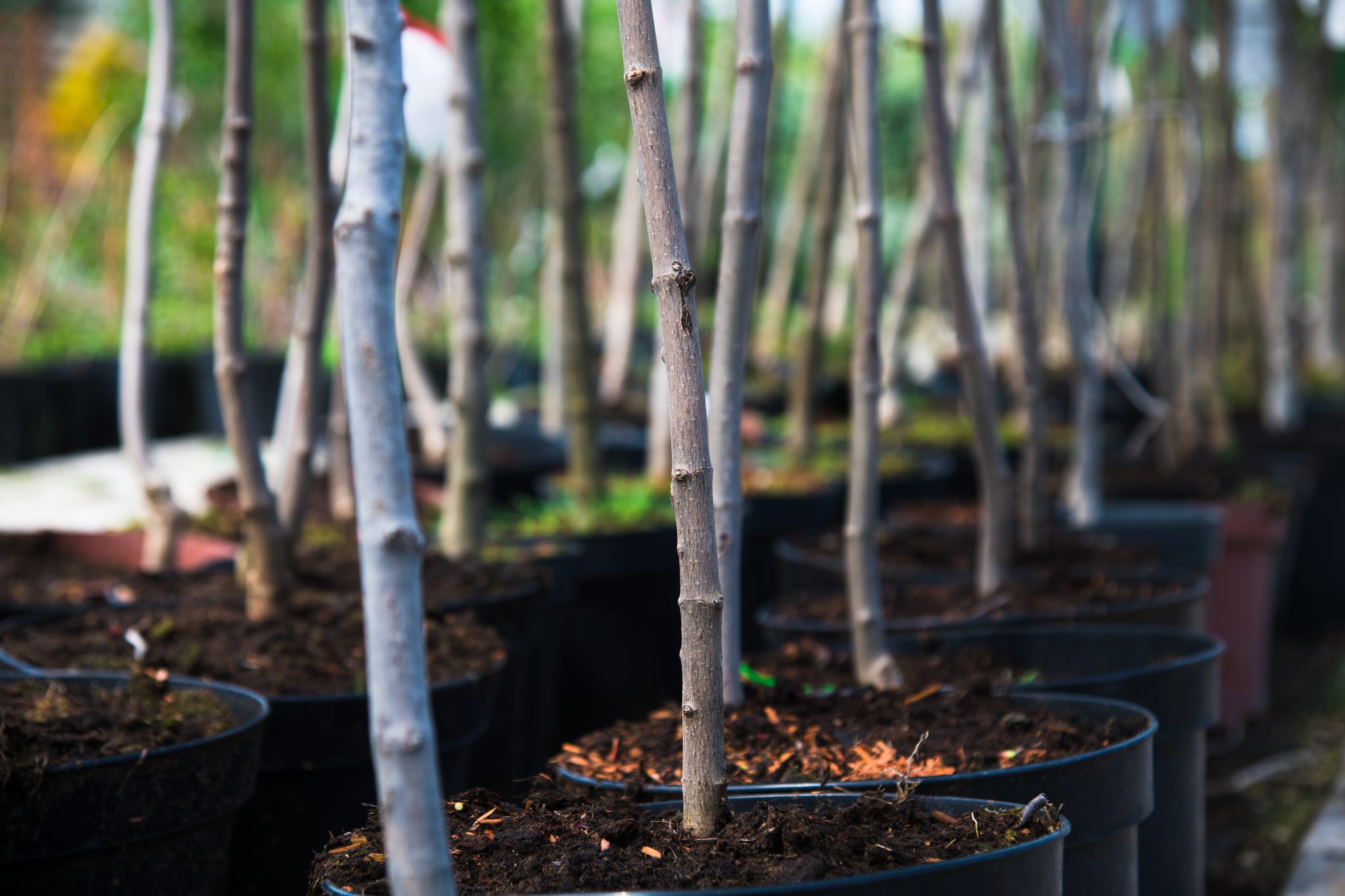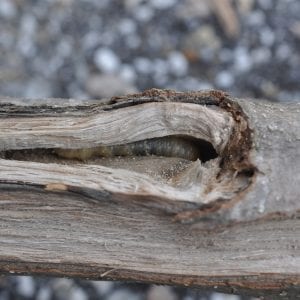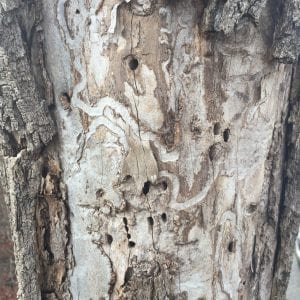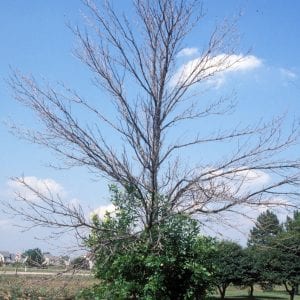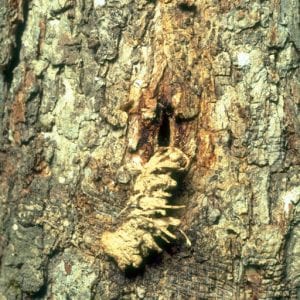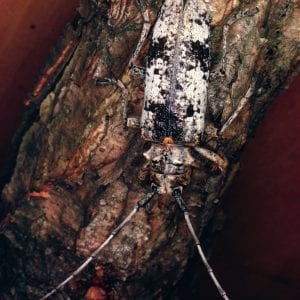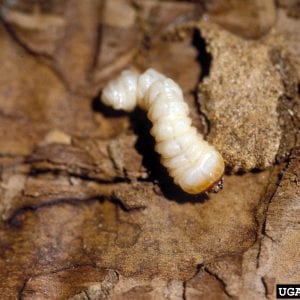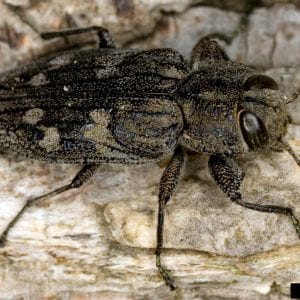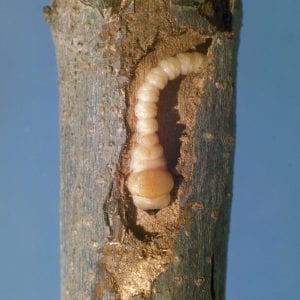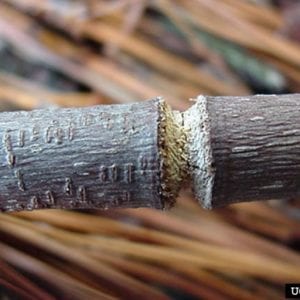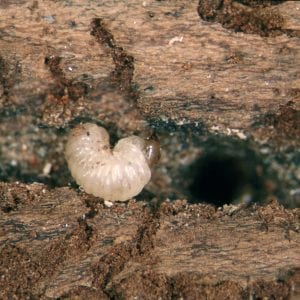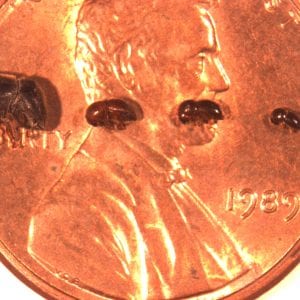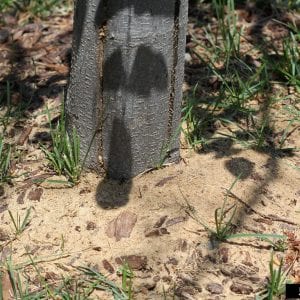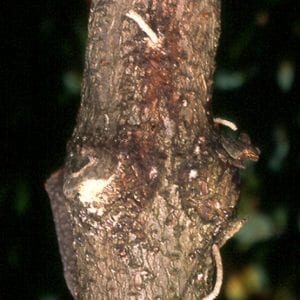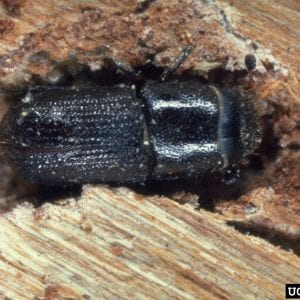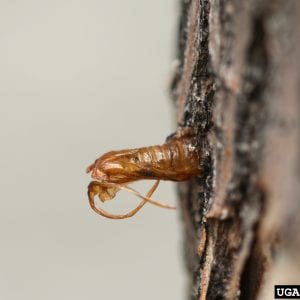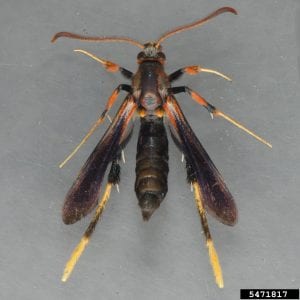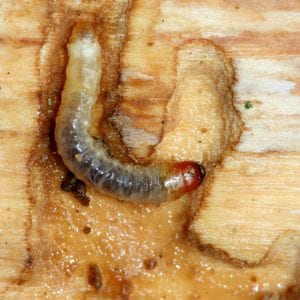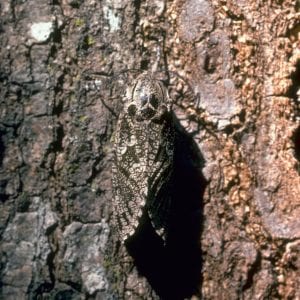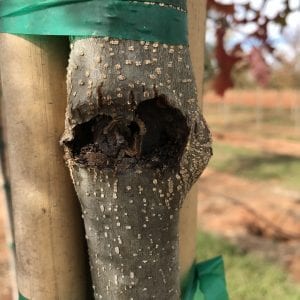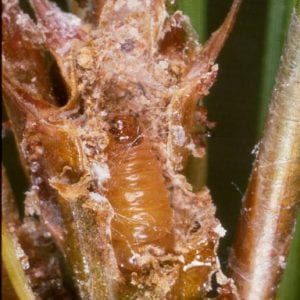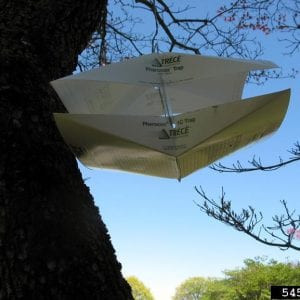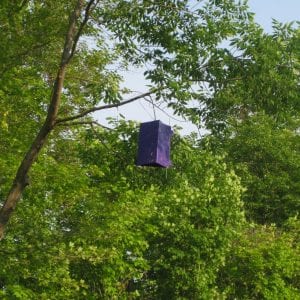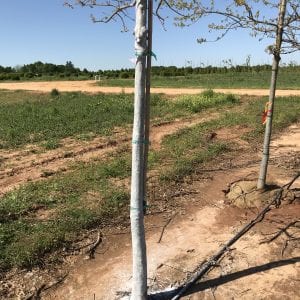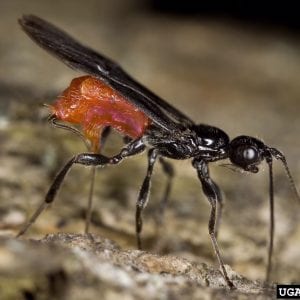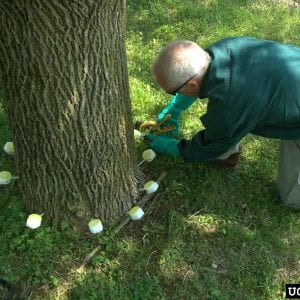Crop Production

Landscapers and nursery producers consider wood-boring insects (borers) to be among the most difficult to control. Many of the most problematic species—emerald ash borer, granulate ambrosia beetle—have been introduced to the United States, but some native species can also be pests of ornamental plants.
Borer larvae (fig. 1) are the damaging life stage for most species. They develop concealed and protected inside the plant. Their cryptic habits and the concealed nature of their feeding make management and research on these species difficult. Boring insects of woody plants are represented by three insect orders (Coleoptera, Lepidoptera, Hymenoptera) and encompass 20 insect families. Among borers, most pests are beetles and weevils (Coleoptera) followed by trunk, stem, and tip-boring caterpillars (Lepidoptera). In production and in the landscape, borer attacks often coincide with or are preceded by biotic or abiotic stresses, particularly water stress or trunk wounds.
Wood-boring insects are often lumped together as borers but where and how the insects do damage can be important for identification. Borers create a gallery (fig 2.), a cavity inside the plant where the larvae develop. Except for ambrosia and bark beetles, the adult life stage does not enter the plant to lay eggs. Eggs are deposited outside the plant. The young larvae chew a hole and enter the plant soon after hatching from the eggs. Symptoms of borer attacks are generally canopy dieback (fig. 3) and an overall unhealthy appearance. All borers produce sawdust-like frass (insect excrement). Some borers pack the frass into the gallery and others such as ambrosia beetles expel their frass from the gallery through the entrance hole (fig. 4). The adult stages are much easier to identify than the larval stages. Field characteristics, however, can help you identify the larval stages according to insect order and perhaps family.
- Figure 1. Borer larvae are generally the damaging life stage. They develop inside the host plant protected by the plant.
- Figure 2. Galleries are trails created inside a plant where borers feed and develop. The appearance of galleries can be diagnostic. The galleries shown here, made by the emerald ash borer, are S shaped.
- Figure 3. Canopy dieback in an ash tree from an infestation of emerald ash borer. (Photo credit: Daniel Herms, The Ohio State University, Bugwood.org)
Wood-Boring Insect Damage
- Stem and trunk borers. Typically what you think about when you hear borer. The larvae develop inside the trunk or stem gallery then pupate inside the tree.
- Tip borers. Larvae develop in the active growing tips of trees. Examples: pine tip moth and maple shoot borer.
- Root and crown borers. Larvae develop at the soil level or underground. Examples: tilehorned prionus and cottonwood borer.
- Twig pruners. Female beetles lay eggs in growing twigs. The larvae cut the tree branch from inside the twig. They finish development and emerge from the severed twig.
- Twig girdlers. Female beetles girdle the stem with their mouthparts and then deposit eggs. Larvae develop in the desiccating branch. They finish development and emerge from the severed twig. Example: pecan girdler.
- Ambrosia beetles. Adult females are the damaging life stage, not larvae. The females attack trees in large numbers. They enter the tree forming a gallery and then introduce ambrosia fungi. Developing larvae consume the fungus, not the woody plant.
- Figure 4. Some species such as the white oak borer expel frass or excrement through the entrance hole. (Photo credit: James Solomon, USDA Forest Service, Bugwood.org)
- Figure 5. Adult white oak borer, a longhorned beetle adult (Cerambycidae). (Photo credit: James B. Hanson, USDA Forest Service, Bugwood.org)
- Figure 6. Redheaded ash borer larvae is an example of a roundheaded borer. (Photo credit: Daniel Herms, The Ohio State University, Bugwood.org)
Wood-Boring Beetles and Weevils (Order: Coleoptera)
The family Cerambycidae includes adults called longhorned beetles and larvae called roundheaded borers. The adult beetles are among the largest (fig. 5) of all wood borers. The defining characteristic of the adult stage is antennae that are one-half to twice as long as their body. Although some adult longhorned beetles can be found feeding on leaves or flowers, not all adults feed. Larvae (fig. 6) are generally large and can be legless or have three pairs of legs on their thorax, a set of three segments just behind the head. Most insect larvae have a head that has a clear connection with the thorax. The larvae of roundheaded borers have a head that appears small and partially hidden by the thorax. This results in a rounded and abrupt appearance to the head end of the larva. These larvae also have flat patches on the top and bottom that act like grippers to hold them in place within the gallery. Of the more than 300 genera in North America, less than 10 percent are considered pests (table 1).
Table 1. Common Species of Longhorned Beetles (Roundheaded Borers) Common in Landscapes and Nurseries
| Common Name | Scientific Name | Reported Hosts |
|---|---|---|
| Redheaded ash borer | Neoclytus acuminatus | Ash, hackberry, some fruit trees, various hardwoods |
| Twig girdler | Oncideres cingulata | Hickory, pecan, honey locust, maple |
| Branch pruners | Psyrassa unicolor | Pecan, hickory, oak |
| Red oak borer | Enaphalodes rufulus | Red and white oaks |
| White oak borer | Goes tigrinus | White and overcup oaks |
| Cottonwood borer | Plectrodera scalator | Willow, cottonwood, poplar |
| Dogwood twig borer (see Lepidoptera for dogwood borer) | Oberea tripunctata | Dogwood, elm, azalea, viburnum |
| Locust borer | Megacyllene robinae | Black locust |
| Asian longhorned beetle | Anoplophora glabripennis | Maple, poplar, various hardwoods (invasive) |
| Roundheaded appletree borer | Saperda candida | (Rosaceae) pear, apple, crabapple, hawthorn |
| Tilehorned prionus | Prionus imbricornis | Oak, nut trees, various hardwoods |
| Pine sawyers | Monochamus spp. | Pine, spruce, fir, Douglas fir |
In addition to longhorned beetles, common names of pests in this family include roundheaded borers, saperda, and prionus. All except the prionus borers attack aboveground plant parts. The prionus are unique because females lay eggs in the soil near the buttress of trees. The larvae hatch and develop underground as root borers. For the other roundheaded borers, females lays eggs on the surface or near a wound on a tree. The larvae hatch and then tunnel inside.
- Figure 7. Flatheaded apple tree borer adult stage. (Photo credit: David Cappaert, Bugwood.org)
- Figure 8. Flatheaded appletree borer. (Photo credit: James Solomon, USDA Forest Service, Bugwood.org)
- Figure 9. Emerald ash borer adults emerging from D-shaped exit holes, characteristic of borers in the family Buprestidae. (Photo credit: Debbie Miller, USDA Forest Service, Bugwood.org)
The metallic wood-boring beetles or flatheaded borers are in the Buprestidae family. Adults and larvae in this family are distinct enough to recognize by family in the field (fig. 7). Beetles are metallic, elongated, and flattened with short antennae. The larvae are legless and are called flatheaded. The common name originates with the flat (compressed from top to bottom) appearance of the first segments of the thorax (fig. 8). These larvae may also have short cerci (feeler-like structures) at the posterior end of the insect. Cerci are never present in roundheaded borers. As beetles complete development, they pupate inside the tree. As adults, they emerge from the trees creating a D-shaped exit hole (fig. 9). In North and Central America, 92 species in 21 genera are present, but the most important borers of woody plants are in two genera, Chrysobothris and Agrilus (table 2).
Table 2. Common Species of Flatheaded Borers Attacking Woody Plants in Landscapes and Nurseries
| Common Name | Scientific Name | Reported Hosts |
|---|---|---|
| Flathead appletree borer | Chrysobothris femorata | Maples, particularly red maples in production |
| Twolined chestnut borer | Agrilus bilineatus | Oaks, chestnut |
| Emerald ash borer | Agrilus planipennis | Ash (invasive) |
| Bronze birch borer | Agrilus anxius | White-barked and paper-barked birch. River birch rarely attacked. |
Twig Girdling and Pruning Beetles
Twig girdling and twig\branch pruning can be caused by either metallic wood-boring beetles or longhorned beetles. The adult life stage of twig girdlers and pruners would have the characteristics previously discussed for each of those groups. The larvae stages, if found, look very similar. The primary difference between these two groups is the life stage that damages the twig. Feeding by the adult female beetles causes the girdled twig, but damage from twig pruners is done from inside the twig by a larva. Both develop as larvae in the terminal end of smaller branches (the diameter of a pencil or slightly larger). Twig girdlers feed in a nearly perfect cut around the perimeter of branches (fig. 10). These small branch tips break off with an evenly cut edge. Branches infested with twig girdlers can also break from the tree, usually in a storm in late summer or fall allowing the larvae to overwinter and complete development on the ground inside the stem. The twig pruner larva chews a break in the twig to get it to separate from the branch (fig. 11). The cut end is more ragged and not even. For this reason, the limbs containing larvae may be mistaken for wind damage except that the terminal leaves on the branch will be wilted and brown from feeding. Once on the ground, the larvae remain inside the stems where they can pupate. Removal of these twigs on the ground can reduce some of the developing insects.
- Figure 10. Damage from a twig girdler. (Photo credit: Herbert A. ‘Joe’ Pase III, Texas A&M Forest Service, Bugwood.org)
- Figure 11. Damage from a branch\twig pruner. (Photo credit: James Solomon, USDA Forest Service, Bugwood.org)
- Figure 12. Bark or ambrosia beetle larvae are always legless, but have a head that contrasts with their body. (Photo credit: Whitney Cranshaw, Colorado State University, Bugwood.org)
Bark and Ambrosia Beetles
Two other groups of beetle borers worth noting are the bark and ambrosia beetles. Larvae of both are generally small, legless, and grub-like in appearance (fig. 12) and the adults are the smallest of the wood-boring beetles (fig. 13). These beetles attack as adults by entering trees to lay eggs. Both groups are in the same beetle family (Scolytinae) but differ in life cycle development. Ambrosia beetles attack trees to form a gallery but do not eat wood. As the female produces her gallery, she will produce a large amount of sawdust (fig. 14) or frass sticks (fig. 15). When the gallery is complete, the female beetles infest the tree with ambrosia fungi (Ambrosiella spp.) as a food source for the developing larvae. Fungi are more nutritious food for insects than wood. Ambrosia beetles carry these fungi around in mycangia (fungal pouches) or on their bodies. They infect the gallery to grow fungi as food for developing ambrosia beetle larvae. Most fungi carried by ambrosia beetles do not cause disease in trees attacked by ambrosia beetles. An exception is Raffaelea lauricola, the fungus that causes redbay wilt disease. In this unique case, the non-native redbay ambrosia beetle carries a fungus that is a plant pathogen and causes a vascular wilt disease. Injection of redbay trees with certain fungicides can prevent the growth of the fungus that causes laurel wilt. But systemic fungicides and insecticides are ineffective to kill Ambrosiella or other ambrosia beetles attacking woody plants.
- Figure 13. Bark and ambrosia beetles are the smallest of the wood-boring beetles.
- Figure 14. Sawdust at the base of a tree or shrub can be an indication of a borer infestation. (Photo credit: Whitney Cranshaw, Colorado State University, Bugwood. org)
- Figure 15. Frass sticks are insect excrement and sawdust thrust through the entrance hole of certain ambrosia beetles such as granulate ambrosia beetles. (Photo credit: J. R. Baker and S. B. Bambara, North Carolina State University, Bugwood.org)
- Figure 16. Southern pine beetle adult. (Photo credit: USDA Forest Service–Region 8–Southern, Bugwood.org)
Broadleaf woody plants have a few ambrosia beetles. In the Southeast, the most notable species are the granulate ambrosia beetle (X. crassiusculus, also known as the Asian ambrosia beetle), redbay ambrosia beetle (Xyleborus glabratus), black twig borer (Xylosandrus compactus) and the camphor shoot borer (Cnestus mutilatus). Ambrosia beetles are not particularly host specific, but several have certain woody plants that are commonly attacked in production or the landscape. Tree stress (water and lightning strikes) is related to attack, and localized flooding in nurseries during the beetle flight can explain some of the patchiness of ambrosia beetle attacks.
Granulate ambrosia beetles have multiple generations per year but only seem to attack nursery plants in a single synchronized spring flight (December through April). The spring flight usually coincides with first bloom of ornamental (Callery) pear trees. The severity of the spring flight likely reflects the susceptibility of the trees flooded during more frequent spring rains. But when tropical storms, as in 2017, dump heavy rains in summer, significant attacks can result later in the year. Ambrosia beetles take about 2 months to develop inside a tree. Frass sticks (fig. 15) usually on the trunk are symptoms of an attack by the female. Attacks on woody ornamentals with small holes and frass sticks are commonly caused by granulate ambrosia beetles. Redbay ambrosia beetles are likely the cause of attacks on redbay or camphor trees.
Bark beetles (fig. 16) are most commonly associated with pine trees. Like ambrosia beetles, they are small and attacks are associated with tree stress. Bark beetles also introduce fungi to trees they attack, and this fungus acts as a pathogen helping to kill the tree. Unlike, ambrosia beetles, larvae of bark beetles consume the tree as they develop. Production of pine trees is plagued by several species of bark beetles in two genera, Ips and Dendroctonus. The Ips species are called the engravers and the Dendroctonus species include beetles with common names such as southern pine beetles and black turpentine beetle. Attacks on landscape or nursery trees by these bark beetles are not that common. In the landscape, lightning strikes on pine trees can elicit attacks as can water stress during a drought. These effects are often not seen in the year of the stress but show up the following spring and summer. For example, the drought in the of summer of 2016 led to many pine attacks and tree losses in landscapes from bark beetles in 2017.
Wood-Boring Caterpillars (Lepidoptera)
This order of insects includes the moths and butterflies; however, there are a few families of moths that have larvae (caterpillars) that bore into trees and shrubs. These moths often go unnoticed unless you are using a trap baited with sex pheromones for monitoring. Adults do not have chewing mouthparts and, therefore, can’t burrow in or out of plants as adults the way beetles do. Instead, eggs are laid on the bark in crevices and cracks. Once the eggs hatch, the larvae chew into the stem, branch, or trunk. The caterpillar completes development inside the plant. They pupate near an exit hole so the adult moth can easily emerge. One of the easy ways to distinguish caterpillar borers from beetle borers is the presence of a pupal skin at the hole of the gallery (fig. 17).
- Figure 17. Wood-boring caterpillars leave behind the pupal skin when they emerge. (Photo credit: Whitney Cranshaw, Colorado State University, Bugwood.org)
- Figure 18. Clearwing moths resemble wasps. This species, the ash clearwing borer, could be mistaken for a paper wasp or red wasp. (Photo credit: Mark Dreiling, Bugwood.org)
- Figure 19. A clearwing moth larva (caterpillar) in the gallery. (Photo credit: David Cappaert, Bugwood.org)
Clearwing borers (Sesiidae) are a group of day-active moths whose larvae are plant pests. Adults resemble wasps or hornets and lack scales on the wings that are common in other moths and butterflies (fig. 18). The caterpillars of clearwing moths have three pairs of thoracic legs and abdominal prolegs and a head that contrasts with the body (fig. 19). There are 115 species of clearwing borers in North America. Of these, about forty species are considered economically important pests (table 3). As these larvae bore into the plant, they typically expel their frass (sawdust-like excrement) from the hole. Damage to landscape trees from mowing equipment or string trimmers is a common cause of attacks.
Table 3. Species of Clearwing Borers Common in Landscapes and Nurseries *
| Common Name | Scientific Name | Reported Hosts |
|---|---|---|
| Lilacash borer | Podosesia syringae | Green and white ash, lilac, fringtree, privet |
| Banded ash clearwing | Podosesia aureocincta | White and green ash |
| Peachtree borer | Synanthedon exitiosa | Ornamental and fruit varieties of Prunus |
| Lesser peachtree borer | Synanthedon pictipes | Fruit trees, flowering cherry, beech |
| Dogwood borer | Synanthedon scitula | Dogwood, pecans, hickory, apple, elm, viburnum, callus, and gall tissue on woody plants |
| Maple clearwing | Synanthedon acerrubri | Red and sugar maple, other maples, boxelder |
The carpenterworm is another group of caterpillar borers. Carpenterworm moth larvae are not as common pests as clearwing moths, but they cause significant damage when outbreaks occur. These large moths (fig. 20) are also active in the daytime. They lay eggs on the bark of hardwood trees, mainly oak trees (Quercus spp.) in nurseries. Once those eggs hatch, the larva will tunnel into the tree. The galleries can occur on the main trunk from near the soil line up to the first branch of the tree. Typically, development can take 1 or 2 years, but moths fly, mate, and lay eggs every year. As the larvae develop inside the tree, symptoms of the infestation are not evident as wilting leaves or dieback in the tree canopy, and rarely do trees in the nursery die from an infestation. Most young trees in the nursery are receiving adequate water and nutrients, which likely mask damage in the leaves. However, as the larvae grow a large knot or swelling can form near the feeding site (fig. 21). This is a weak point on the trunk and an aesthetic problem that renders the trees unsalable.
- Figure 20. An adult carpenterworm moth. (Photo credit: James Solomon, USDA Forest Service, Bugwood.org)
- Figure 21. Swelling on the trunk of an oak tree around the entrance and exit hole of a carpenterworm.
- Figure 22. A few families of small moths have caterpillars that bore into the new shoots of trees and shrubs.
A final group of moths that can be borers have larvae that infest the actively growing tips of trees (fig 22). Moths with this habit are called tip-boring moths. They are represented by several families of small moths. Common examples of tip-boring moths are Nantucket pine tip moth and maple shoot borer. Like other borers, larvae develop hidden inside the plant, but these larvae develop exclusively in the terminal end of the branch. This is a problem because the tree loses a central stem when the terminal shoot is killed. As the tree grows, the lower branches grow more rapidly in the absence of a central stem causing the tree to grow wider than tall.
Identification of the tree infested by the tip-boring larvae can provide reasonable identification of the larvae. Tip-boring larvae attack plants in one genus or closely related species. The number of generations per year and the location where the insects pupate can vary between species. For these reasons, identification is necessary to properly manage these pests. Other than larvae of moths, a few species of sawflies and certain bees can also nest inside plants. Sawflies are related to bees and the larvae resemble caterpillars. Rose is a common landscape plant that could have canes infested by wood-boring sawfly larvae.
Monitoring Borer Activity
Because borer attacks often lead to the death of the tree, it is important to monitor the activity and understand the biology of these insects. Traps collect the adult stages of these borers when they are active. Traps and various chemical lures are commercially available from vendors (table 4) that feature integrated pest management (IPM) supplies. Companies that sell traps and lures also can provide technical assistance in the proper uses and deployment of their traps. This expertise is an advantage to purchasing traps from a company that specifically sells IPM supplies versus a generic online retailer.
Table 4. Commercial Sources of Traps and Lures for Monitoring Borers
| Company | Website |
|---|---|
| AlphaScents | www.alphascents.com |
| Arbico Organics | www.arbico-organics.com |
| ChemTica | www.chemtica.com/ |
| Gempler’s | |
| Trécé Inc. |
Most traps will either intercept the insect in flight or lure the insect to the trap with attractive colors or smells (usually sex pheromones). Sex pheromones for use in traps are commercially available for most caterpillar borers. Sex pheromones attract males (and only males) to traps where they can be captured and counted. Pheromones are specific to a species of borer and will only attract the insect listed on the pheromone label. Male moths do not lay eggs and may emerge before and have longer flights than females. Traps baited with pheromones (fig. 23) are not a perfect monitoring method because they only recruit males, but they do provide a target window for moth activity. Moth captures in pheromone traps can then be used to time the application of insecticides or to scout for eggs on trees. For example, a common recommendation is to treat trees with insecticides about 2 weeks after the first moth is captured in a pheromone trap. This allows time for mating, egg lay, and egg hatch. With this approach, young larvae encounter insecticides and are killed before they enter the tree. Repeated applications, if permitted by the product label, may be needed if flight continues.
Sticky traps or bands can also be used with or without a chemical lure. A purple panel sticky trap (fig. 24) is commonly used to monitor flatheaded (Buprestidae) movement in nurseries. Purple panels are one example of using color as an attractant. Because many borers are attracted to trees that are not healthy, ethanol (alcohol) can also be used as a lure. Ethanol is a scent produced by trees under certain types of stress. These lures are not specific to one type of borer. They are available commercially, and most are designed to release ethanol slowly (less than 100 mg per day) over several weeks or months. Several groups of borers are attracted to ethanol traps, so the identification of trapped species is still necessary.
- Figure 23. A wing-type trap baited with pheromones is commonly used to monitor the flight of moths. (Photo credit: Dawn Dailey O’Brien, Cornell University, Bugwood.org)
- Figure 24. A purple panel trap uses color to attract certain beetle borers. (Photo credit: Dawn Dailey O’Brien, Cornell University, Bugwood.org)
Management of Borers
Prevention—the most important management tactic for borers. Stress is the best precursor to attacks by many wood borers, especially beetles. Stressed plants produce ethanol, which is a cue used by these borers to find the stressed plant. While water (drought or flooding) is one of the most common stresses, lightning strikes and bark injuries due to mowing are also stresses. Proper horticultural practices are important to reduce stress on plants. Watering plants during droughts or ensuring proper planting depth to discourage wet roots are two practices to address water stresses in woody plants.
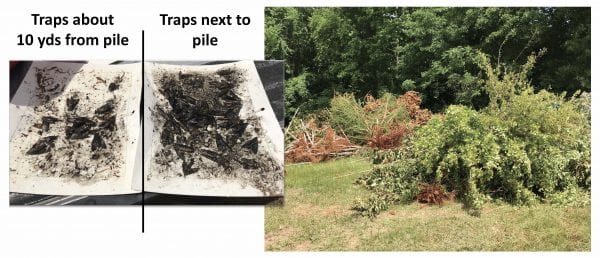
Figure 25. Trees infested with borers can be a source of new borers. The pheromone trap nearest to this pile at a nursery captured a large number of borers (carpenterworm moths).
One issue with infestations of borers is disposal. The severed twigs of girdlers and pruners that accumulate on the ground under infested trees contain larvae or pupae. Trunk borers may remain inside infested trees left in the field. When producers cull trees, they tend to push them into a pile for disposal (fig. 25). Each of these situations can produce a reservoir of emerging adult borers. Burning culled trees can usually solve the problem. No data indicates when you should cull plants—first sign of infestation or after the flight activity has passed. With granulate ambrosia beetles, five to ten attacks will likely result in death, especially when the tree is 3 inches or less in caliper. In nurseries, trees attacked by granulate ambrosia beetles are left until the flight period is finished. If in containers, plants could be moved to the edge of the block to serve as trap trees. Leaving the trees in the block does not seem to increase the likelihood of attacks on adjacent trees. Trap trees may intercept or divert beetles that would otherwise attack different trees in the block. This method may work for other borers as well.
In landscapes, tree companies use chippers or grinders to reduce tree mass on site. In experiments with emerald ash borer larvae, few survive processing through chippers or grinders. But if any do survive, they could live in the shredded material if it is not heat treated or burned. The screen size on grinders may also influence whether borer larvae survive. Mechanical control can also be achieved on a small scale (landscape trees) by inserting a stiff wire into the entrance of the gallery. The wire can impale the borer and prevent further damage.
There are a limited number of studies investigating exclusion of borers from trees. Barrier treatments are applied to trees (usually the trunk) to prevent the borers from reaching the trees or to deter or intercept borer larvae before they enter the trees. Barrier treatments on tree trunks are not commonly used in practice in production nurseries because they are labor intensive to apply but could be useful for protecting specimen trees in the landscape. To be effective, barrier treatments also must be applied proactively, without knowing where or when a borer pest will attack. The effectiveness or success of barriers depends on their persistence and how often they must be re-applied. Sprayable fibrous barriers such as ethylene vinyl acetate can reduce attacks by dogwood borers but only seem to last 2 years. Particle film barriers such as kaolin clay (fig. 26) lose residue depending on the amount and frequency of rainfall or overhead irrigation. One springtime application of kaolin along with or mixed with a pyrethroid reduces attacks by the granulate ambrosia beetle.
Host plant resistance. Even though many borers bear the name of a preferred or common host, many can develop in related and sometimes unrelated hosts. For example, the flatheaded apple tree borer can develop in maple, apple, and 15 or so other woody plants. Emerald ash borer larvae can develop in unrelated white fringetree (Chionanthus spp.), and dogwood borer larvae can develop in a wide range of callus or gall tissues on different trees, not just dogwood. This is one reason why host plant resistance has not been particularly well researched for woody plant borers. Some notable successes are observed with borers, such as the peachtree borer and the lesser peachtree borer, that are more host specialists.
Biological controls. Virtually every wood-boring insect has one or more biological controls. Many of them can be attacked by other insects. Certain parasitoids, for example, have long ovipositors (fig. 27) to penetrate inside the gallery to sting the developing larva. Programs to introduce species of natural enemies have been successful for borers not native to the United States. These programs are intended to release natural enemies in a state or region and are not for commercial use. Biological controls (nematodes) or insecticides can be injected through the external hole of the gallery. This practice is sometimes successful in eliminating an infestation once the larva is inside the tree. Like the wire method mentioned above, this would only be cost effective on a small scale.
- Figure 26. An oak tree just after a trunk spray of kaolin clay was applied. For comparison, note the tree on the right that was not treated.
- Figure 27. Parasitoids that attack borers have a long ovipositor so they can sting the larvae in the gallery and deposit an egg. (Photo credit: David Cappaert, Bugwood.org)
- Figure 28. Trunk injections can be used to control certain borers in landscape trees. (Photo credit: David Cappaert, Bugwood.org)
Chemical controls. Chemical controls for borers are often used in the production of ornamental plants and are sometimes applied to landscape plants. Chemical control requires accurate timing. Timing is guided by trap captures for most species. The optimal place to apply insecticides for most borers is to the trunk. Trunk injections deliver the insecticide directly to the tree saps, and trunk sprays require borers to move through an insecticide barrier to enter the tree. Trunk treatments can be used to prevent borer attacks in the landscape but are time consuming or cost prohibitive for large blocks of trees in nurseries. Airblast sprays are used in nurseries to deliver insecticides to trees. These sprays provide economy on a large scale but through drift tend to overapply insecticides to the tree canopy and nonhosts. Overspray of treatments targeting ambrosia beetles can cause outbreaks of secondary pests such as spider mites.
Find a complete list of pesticides available for borer control in the Southeastern US Pest Control Guide for Nursery Crops and Landscape Plantings. Bifenthrin and permethrin, synthetic pyrethroid insecticides, are the most commonly used for borer control. It is important to read the use site information on the label because some products may be labeled for use in landscapes but not in nurseries and vice versa. Spinosad and chlorantraniliprole can also be used against caterpillar borers and tip borers. Some products containing older chemistries, such as carbaryl and chlorpyrifos, may have one or more borer species on their labels. And some products are specially formulated for application using tree injection equipment, such as Arbor-Jet or Mauget. These materials act like an intravenous therapy (IV) for trees (fig. 28) infested with borers and are useful in landscapes where a spray may not be wise or lawful.
Selected Resources on Borers
Websites
Bark beetles genera of the United States
Emerald ash borer
Redbay ambrosia beetle
https://www.fs.fed.us/research/invasive-species/insects/red-bay-ambrosia-beetle.php
Field Guide to the Jewel beetles of Northeastern North America
http://www.biodiversityinfocus.com/pdfs/Jewel_Beetle_Field_Guide_English.pdf
Products for Chemical Control of Borers
Southeastern US Pest Control Guide for Nursery Crops and Landscape Plantings
Books
Insects that Feed on Trees and Shrubs, by W. T. Johnson and H. H. Lyon
Garden Insects of North America: The Ultimate Guide to Backyard Bugs 2nd Edition by W. Cranshaw and D. Shetlar
Download a PDF of Borer Pests of Woody Ornamental Plants, ANR-2472.


